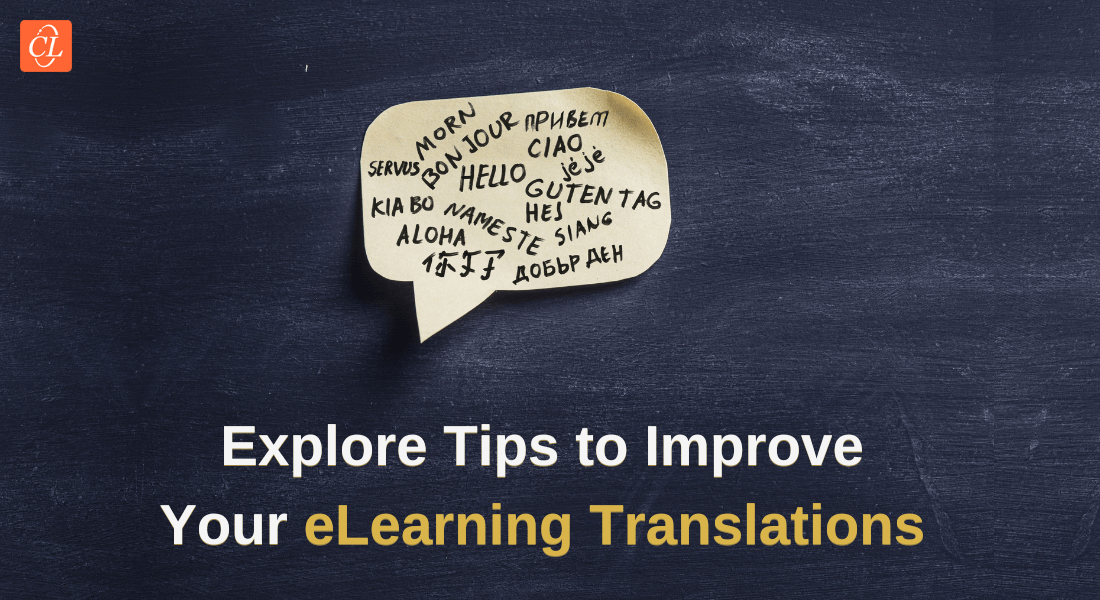How Rapid eLearning Translations can Enhance the Quality of Corporate Training

ELearning translations are a critical need for organizations that have employees around the world and want to make sure that the impact of their corporate training isn’t nullified because of language barriers. Rapid eLearning solutions can quickly translate eLearning materials, such as online courses or training modules, into multiple languages. Rapid eLearning translations are made easier with the help of modern authoring tools as the courses can be imported/exported without any sort of complications. In this blog, we’ll explore some of the benefits of rapid eLearning translations, as well as some tips for making the process as efficient and effective as possible.
Hard to Scale Corporate Training Globally? Try Rapid eLearning Translations!
Check out some of these tips to ease out the process –
- Outsource to a professional vendor
- Use translation memory tools
- Plan ahead and set your goals and expectations
- Use clear and concise language
What is The Need for Rapid eLearning Translations?
Enhances Engagement on a Global Scale
One of the main benefits of rapid eLearning translations is that they allow organizations to expand their reach and tap into new markets. By translating their eLearning content into multiple languages, organizations can make their courses and training materials accessible to a wider audience, which can help to increase enrollment and engagement. This can be especially valuable for businesses that operate in a global market and want to attract international customers or clients.
Maintains the Relevancy of Courses for Non-English Learners
Another benefit of rapid eLearning translations is that they can help to ensure that the content is accurately and effectively communicated to learners in different languages. Professional translation services can help to ensure that the rapid eLearning courses are translated accurately and that the meaning and intent of the master course is maintained in the translated version. This is important for ensuring that learners understand and effectively apply what they have learned.
Check out how we implemented rapid eLearning translations for a global energy major.
A Few Tips to Ensure the Quality of Rapid eLearning Translations
Outsource to a professional vendor
Outsourcing rapid eLearning translations to an external vendor or professional translation services can help to ensure that the content is accurately translated. It’s important to choose a service that has considerable experience translating various types of eLearning content, holds expertise in multiple languages, and can work efficiently to meet tight deadlines.
Use translation memory tools
Translation memory tools can help to streamline the translation process by storing translations of commonly used phrases and terms. This can help to save time and reduce the need for multiple rounds of revisions. Some translation services also offer additional services such as cultural adaptation, which can be especially important when translating eLearning content for learners in different parts of the world. Cultural adaptation involves adapting the content to the cultural norms and expectations of the target audience, which can help to ensure that the material is more relevant and meaningful to learners.
Plan ahead and set your goals and expectations
The more time you have to plan for rapid eLearning translations, the better. Start planning as early as possible to ensure that you have enough time to work with a translation service, review the translated content, and make any necessary revisions. It’s also a good idea to set clear goals and expectations for the translation process and to communicate these to the translation service and any other stakeholders involved in the process.
Best Practices to Overcome Challenges Associated with Rapid eLearning Translations
The demand for rapid eLearning translations has increased significantly in recent years, as more and more organizations now recognize the value of making their eLearning accessible to a global audience. Whether it’s an online course, a training module, or some other type of eLearning material, translating it into multiple languages can help organizations enhance the participation of their global workforce.
But rapid eLearning translations have their own set of challenges. Ensuring that the content is accurately and effectively communicated to learners in different languages can be a complex and time-consuming task. It’s important to work with a vendor that has prior experience translating eLearning courses on a large scale and can work efficiently under tight deadlines while managing your own budget is always a burden as well. To encounter rapid eLearning translation challenges such as translating complex content, there are various things you can do or ask your vendor to do. For example –
Use clear and concise language
Keep in mind that the content will be translated into multiple languages, so it’s important to use clear and concise language in the original version. This can help to make the translation process more efficient and ensure that the meaning and intent of the content are maintained in the translated version. Avoid using region-specific phrases and metaphors because they can have different meanings in various languages at times.
Use visual aids
Visual aids such as images, videos, and infographics can be helpful in conveying complex concepts and ideas and make the courses more engaging and interesting for learners. You can use the content library of any popular rapid eLearning authoring tool to find relevant visual assets. Make sure to include a mix of visual aids in your eLearning content to make it more effective.
Use consistent terminology
Using consistent terminology throughout the eLearning course can help to make the translation process easier and more accurate. It’s a good idea to create a glossary of terms and make sure that they are consistently used throughout the content.
Parting Thoughts!
Rapid eLearning translations are critically valuable for organizations that are spread globally because they can ensure the preferences of their learners are considered and their culture is valued. By working with a professional translation service, using translation memory tools, and planning ahead, organizations can make the process as efficient and effective as possible. If you still have a doubt or two wandering inside your head, you can access this free eBook and clear them out.




![9 Ways eLearning Works Better than Classroom Training [Infographic]](https://blog.commlabindia.com/hubfs/Imported_Blog_Media/positives-of-online-training-infographic.jpg)
